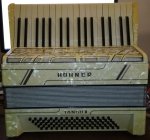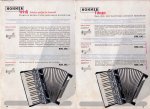Im about to embark on my next restoration project, so Ill do another another dissection here for anyone who might be interested in these old boxes. Before anyone states the obvious - yes, I realise this accordion is worthless, etc, etc.
<ATTACHMENT filename=Hohner Tango II.jpg index=1>
Here we have a late 1930s Hohner Tango II. Ive seen a photo of it with the original owner dating to 1939, so this would be from the first half of its production run (1937 - 1942, according to the online Hohner model list).
Heres an extract from a 1937 catalogue:
<ATTACHMENT filename=Hohner1937_6.jpg index=0>
(The full catalogue can be found by using my instructions here: https://accordionists.co.uk/viewtopic.php?f=25&t=3346#p33747)
This is a 34 key, 80 bass instrument with 3 voices (LMM) in the treble, and 5 voices in the bass.
Theres a palm switch that changes the treble from MM to LMM. There are no bass switches.
Im really impressed with the state of this accordion. Its clearly had maintenance done, because theres no way an 80 year old instrument will be in this state. The mechanics are in really good condition and its pretty airtight.
Here is a demonstration of what the instrument currently sounds like:
More details and photos below.
<ATTACHMENT filename=Hohner Tango II.jpg index=1>
Here we have a late 1930s Hohner Tango II. Ive seen a photo of it with the original owner dating to 1939, so this would be from the first half of its production run (1937 - 1942, according to the online Hohner model list).
Heres an extract from a 1937 catalogue:
<ATTACHMENT filename=Hohner1937_6.jpg index=0>
(The full catalogue can be found by using my instructions here: https://accordionists.co.uk/viewtopic.php?f=25&t=3346#p33747)
This is a 34 key, 80 bass instrument with 3 voices (LMM) in the treble, and 5 voices in the bass.
Theres a palm switch that changes the treble from MM to LMM. There are no bass switches.
Im really impressed with the state of this accordion. Its clearly had maintenance done, because theres no way an 80 year old instrument will be in this state. The mechanics are in really good condition and its pretty airtight.
Here is a demonstration of what the instrument currently sounds like:
More details and photos below.











